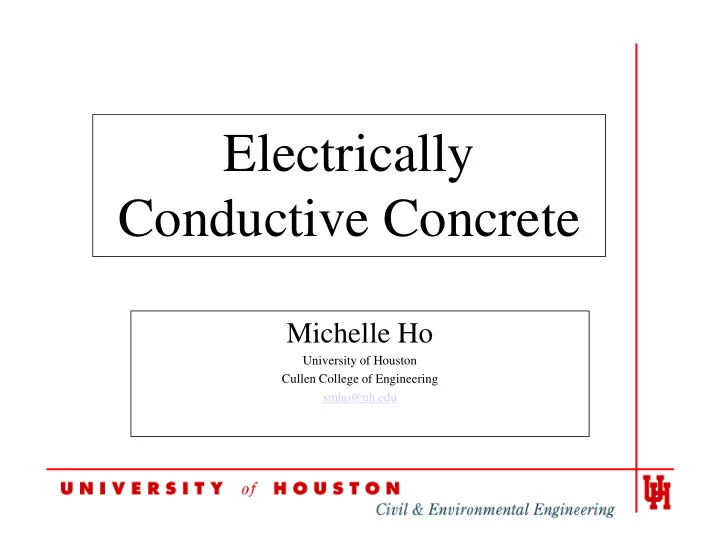

Electrically Conductive Concrete Michelle Ho University of Houston Cullen College of Engineering smho@uh.edu
Electrically Conductive Concrete • Definition � Chopped Carbon Fiber (CCF) � Resistive heating � Resistive heating
Problem • Ice and snow build-up � driving hazards � traffic and time delays
History and Past Projects • Sodium chloride � Pros � Inexpensive � Simple application � Cons � Cons � Ruins groundwater and vegetation � Corrosion of reinforcing bars � Concrete surface damage
History and Past Projects (cont’d) • Heating cables � Pros � Effective deicing � Cons � Traffic disturbances � High energy costs � High energy costs • Heating Pipes � Pros � Effective deicing � Cons � Leaks lead to almost impossible maintenance � Complex and costly
Purpose – Solving the de-icing problem – Achieving and maintaining cost efficiency – Achieving and maintaining cost efficiency – Reduce damage and maintenance to concrete and environment
Scope • Investigation into conductive concrete’s: – Resistive properties – Heating properties – Heating properties
Design of System
Design of System (cont’d) • Two types of electrodes – Zinc Perforated Metal Sheets (a) – Aluminum Mesh (b) (a) (b)
Procedures • Resistivity Testing � Two point probe method � Input: voltage � Output: current readings � V = I * R � Slope: resistance • Heating Testing – Heating and Cooling – Temperature and current Sample connected to a power readings supply
Resistivity Results Average Resistance (Ohms) vs. % CCF by Mass of Cement 500 450 400 350 ance ( � ) 300 Resistan 250 250 200 150 100 50 0 0.80 0.90 1.00 1.10 1.20 1.30 1.40 1.50 1.60 1.70 1.80 % CCF by Mass of Cement Zinc Mesh
Resistivity Results (cont’d) Resistance (Ohms) vs. % CCF by Mass of Cement 500 450 400 350 ce ( � ) 300 Resistance 250 200 150 100 50 0 0.80 0.90 1.00 1.10 1.20 1.30 1.40 1.50 1.60 1.70 1.80 % CCF by Mass Cement Zinc Mesh
Problem • Due to the unexpected high amount of resistance encountered when the sample was frozen, which did not occur when the was frozen, which did not occur when the sample was at room temperature, a heating and cooling test were done to investigate the relationship between temperature and resistance.
Cooling Results 3000 Cooling 1% CCF Cooling 1.67% CCF 2500 2000 ce ( � ) Resistanc 1500 1000 500 0 -10 -5 0 5 10 15 20 25 Temperature (° C)
Heating Results 2000 1% CCF Heating 1.67% CCF Heating 1800 1600 1400 nce ( � ) 1200 Resistan 1000 800 600 400 200 0 -15 -10 -5 0 5 10 15 20 Temperature (° C)
Example of mortar blocks in a freezer
Discussion • Resistive Testing � Correlation � Inversely proportional relationship between resistance and percentage of CCF � Increase in CCF triggers a decrease in resistance and increase in current
Discussion (cont’d) • Heating Testing � Problem � Resistance too high (quadrupled) � Resistance too high (quadrupled) � Only .05 A and 1 W power output with 20 V input � Correlation: Inversely proportional relationship between temperature and resistance
Future Work • Design better concrete system to solve resistance problem in the heating test • Various course aggregates • Various course aggregates and admixtures • Sonication and compaction – eliminate entrapped air bubbles in non-solidified Fly Ash concrete mixtures
Acknowledgements • Dr. Mo – REU advisor • Dr. Gangbing Song – Faculty Mentor • Christiana Chang – Masters Mentor • The research study described herein was • The research study described herein was sponsored by the National Science Foundation under the Award No. EEC-0649163. The opinions expressed in this study are those of the authors and do not necessarily reflect the views of the sponsor.
References • http://www.newsgd.com/news/picstories/content/images/attachement/j pg/site26/20080204/0010dc53fa040910b7cd05.jpg • http://www.fhwa.dot.gov/PAVEMENT/recycling/fach01.cfm • http://www.tohotenax.com/tenax/en/products/images/photo_chopped.j pg • http://img.directindustry.com/images_di/photo-g/chopped-carbon- fiber-363314.jpg fiber-363314.jpg • http://www.allwarm.com/images/installdway1.jpeg • http://www.instablogsimages.com/images/2008/01/01/roadenergysyste ms_6648.jpg • http://www.dailycommercialnews.com/images/archivesid/32825/400.j pg • Christiana Chang (2009). “Development of Self-Heating Concrete Utilizing Carbon Nanofiber Heating Elements.”
References (Cont’d) • Cress, M. D. 1995. “Heated bridge deck construction and operation in Lincoln, Nebraska.” IABSE Symp., San Francisco, 449–454. • Roosevelt, D. S. 2004. “A bridge deck anti-icing system in Virginia: Lessons learned from a pilot study,” Final Rep. No. VTRC 04-R26, Virginia Transportation Research Council, Charlottesville, Va. • Sun Mingquing, Li Zhuoqiu, and Mao Quizhao. 1997. “Study on the Electrothermal Property of CFRC[J].” Journal of Wuhan University of Technology. V 19. Issue 2. 72-74. • Tang, Zuquan. June 2006. “Influential Factors on Deicing Performance of electrically Conductive Concrete Pavement.” Journal of Wuhan University of Technology – Mater. Sci. Ed. Volume 21. No 2. • Tang, Zuquan, Li Zhouqiu, Hou Zuofu, et al. 2002. “Influence of Setting of Electrical Conductive concrete Heating Layer on Effectiveness of Deicing[J].” Journal fo Wuhan University of Technology – Mater. Sci. Ed. Volume 17. Issue 3. 41-45. • Tuan Christopher Y. March 2008. “Roca Spur Bridge: The Implementation of an Innovative Deicing Technology.” Journal of Cold Regions Engineering (U. of Nebraska). Volume 22 Issue 1, 1-15. • Tuan, Christopher Y. 2004. “Electrical Resistance Heating of Conductive concrete Containing Steel Fibers and Shavings.” ACI Materials Journal, V. 101, No. 1. 65-71. • Williams, D., Williams, N., and Cao, Y. (2000). “Road salt contamination of ground water in major metropolitan area and development of a biological index to monitor its impact.” Water Research, 1 (34), 127-138. • Yehia, Sherif and Tuan, Christopher Y. 1998. “Bridge Deck Deicing.” Transportation Conference Proceedings, Department of Civil Engineering, University of Neraska-Lincoln. 51-57. • Yehia, S. A., Tuan, C, Y., Ferdon, D., and Chen B. 2000. “Conductive Concret Overlay for Bridge Deck Deicing: Mixture Proportioning Optimization, and Properties.” ACI Materials Journal. V. 97, No. 2. 172-181.
Recommend
More recommend